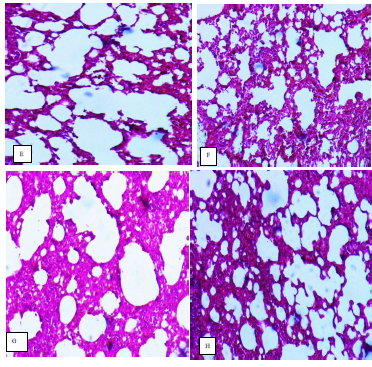Toxicological assessment of the aqueous leaves extract of Combretum platypterum (Welw) Hutch & Dalziel
Main Article Content
Abstract
Combretum platypterum belongs to the family of Combretaceae. The leaf is used to treat fever, conjunctivitis, febrifuge, coughs, sexually transmitted diseases, diarrhea, and as a tonic. Despite it being used in ethnomedicine to treat various sicknesses, the safety profile of the leaf extract has not been reported. This study was aimed at testing the acute and sub-acute toxicological assessments of the aqueous leaf extract of Combretum platypterum.The acute study was carried out using mice and rats. In sub-acute experiments, the animals received 0.5, 1, and 2.5 g/kg of the plant extract orally per day for 28 days. The first weight and the last weight were taken. The liver, spleen, kidney, heart, lungs, and stomach were obtained, weighed, and fixed. Blood was obtained for haematology and biochemical assays. The LD50 of the root extract was indeterminable since there was no death in the mice and rats used. The leaf extract significantly increases (p<0.05) the body weight at the dose of 2.5g/kg compared to control. The body weight index was not affected compared to control (p>0.05). At 0.5 and 1 g/kg, the extract significantly increased the level of monocytes (p < 0.05) compared to the control. haematological parameters were not affected. Upon bichemical analysis of the leaf extract, 2.5 g/kg significantly (P<0.05) increased the level of HDL and 0.5 and 1 g/kg significantly (P<0.05) increased the level of TRI compared to control. Other parameters were not affected. This study shows that aqueous root extract is safe.
Article Details
References
. Aigbokhan EI. Annotated checklist of vascular plants of southern Nigeria- A quick reference guide to the Vascular Plants of Southern Nigeria: a systematic approach. Uniben Press, Benin city, (2014) Pp 346
. Bautista AR. Moreira, EL, Batista, MS, Miranda, MS, Gomes. IC. Subacute toxicity assessment of annatto in rat. Food Chem. Toxicol., 2004, 42: 625-629. DOI: https://doi.org/10.1016/j.fct.2003.11.007
. Bongers F, Parren MPE, Traoré D. Forest Climbing Plants of West Africa: Diversity, Ecology and Management. CABI, Wallingford, United Kingdom, (2005) 273 pp. DOI: https://doi.org/10.1079/9780851999142.0000
. Bredenkamp CL. Combretaceae: In: O.A Leistnered, Seed plants of southern Africa: Families and Genera Strelitzia. National Botanical Institute. Pretoria, (2000), 10: 228 – 229.
. Calixto JB. Efficacy, Safety, quality control, marketing and regulatory guidelines for herbal medicines (Phytotherapeutic agents). Braziliam Journal of Medical and Biological Research, (2000), 33(2): 179 – 189 DOI: https://doi.org/10.1590/S0100-879X2000000200004
. Doumas BT, Bayse DD, Carter RJ, Peters Jr T, Schaffer R. A candidate reference method for determination of total protein in serum. I. Development and validation. Clin. Chem., 1981, 27: 1642-1650 DOI: https://doi.org/10.1093/clinchem/27.10.1642
. Doumas BT, Wu TW. The measurement of bilirubin fractions in serum. Crit. Rev. Clin. Lab. Sci., 1991, 28: 415-445 DOI: https://doi.org/10.3109/10408369109106872
. Doumas BT, Watson WA, Biggs, HG. Albumin standards and the measurement of serum albumin with bromcresol green. Clin. Chim. Acta, 1971, 31: 87-96 DOI: https://doi.org/10.1016/0009-8981(71)90365-2
. Hodge HC, Sterner JH. Tabulation of Toxicity Classes. Am. Ind. Hyg. Assoc. Quart. 1949; 10:93–96. DOI: https://doi.org/10.1080/00968204909344159
. Hodge HC, Sterner JH. Combined tabulation of toxicity classes.In: Spector, W.S. Handbook of Toxicology, Philadelphia, W.B.Saunders Company, (1956).
. Idu M. Phytomedicine in Nigeria – Past, Present and Future. 7th Professor James Ogonor Memorial Lecture. Woman’s Health and Action Research centre, Benin City, (2010). Pp 10 – 31.
. Karthikeyan S, Gobianand K, Pradeep K, Mohan CV, Balasubramanian MP. Biochemical changes in serum, lung, heart and spleen tissues of mice exposed to sub-acute toxic inhalation of mosquito repellent mat vapour. Journal of Environmental Biology, (2006), 27: 355-358
. Liben L. Combretaceae. Flore du Cameroun. Volume 25. Museum National d’Histoire Naturelle, Paris, France, (1983), 97 p.
. Miller LC, Tainter ML. Estimation of the LD50 and its error by means of logarithmic probit graph paper. Proceedings of the Society for Experimental Biology and Medicine, (1944), 57: 261-264. DOI: https://doi.org/10.3181/00379727-57-14776
. Mukeshwar P, Mousumi D, Shobit C, Surender KC. Phytomedicine: An ancient approach turning into future potential scource of therapeutics. Journal of Pharmacognosy and Phytotherapy, (2011). 3(3): 27 – 37.
. Olson H, Betton G, Robinson D, Thomas K, Monro A, Kolaja G, Lilly P, Sanders J, Sipes G, Bracken W, Dorato M, Van Deun K, Smith P, Berger B, Heller A. Concordance of the Toxicity of Pharmaceuticals in Humans and in Animals. Regulatory Toxicology and Pharmacology, (2000), 32:56–67 DOI: https://doi.org/10.1006/rtph.2000.1399
. Oshomoh EO, Idu M, Uwaya OD. Acute and Sub–acute. Toxicity of the Aqueous Extract of the Stem of Masularia acuminate (G. Don) Bullock ex Hoyle on albino Rats and Mice. Pharmacognia. (2013), 4: 606–616. DOI: https://doi.org/10.5567/pharmacologia.2013.606.616
. Owolabi OJ, Omogbai EKI, Oduru EE. (2008). Antidiarrhoeal Evaluation of the aqueous leaves extracts of costuslucanusianus family Costaceau. Journal of Applied Science Reseach, CO: CC – CC.
. Ozolua IR, Ogochukwu NA, Okpo SO, Idogun SE. Acute and sub-acute toxicological assessment of the aqueous seed extract of Persea Americana mill (lauraceae) in rats. African Journal of Traditional. CAM, (2009). 6 (4): 573 – 578 DOI: https://doi.org/10.4314/ajtcam.v6i4.57214
. Ozolua RI, Idogun SE, Tafame GE. Acute and sub- acute toxicolgical assessment of aqueous leaf extract of bryophyllum pinnatum (Lam) in sprague-dawley rats. Americal Journal of Pharmacology Toxicology, (2010), 5: 145 – 151 DOI: https://doi.org/10.3844/ajptsp.2010.145.151
. Raymond-Habecker J, Lott JA. Principle of Analysis of Alkaline Phosphatase. In: Clinical Chemistry, Theory, Analysis and Correlation, Kaplan, L.A., A. Pesce and S. Kazmierczak (Eds.). Mosby, St. Louis, 1995, pp 521-522
. Schumann G, Bonora R, Ceriotti F, Ferard G, Ferrero CA. IFCC primary reference procedures for the measurement of catalytic activity concentrations of enzymes at 37 degrees C. international federation of clinical chemistry and laboratory medicine. Part 5. Reference procedure for the measurement of catalytic concentration of aspartate aminotransferase. Clin. Chem. Lab. Med., 2002, 40: 725-733 DOI: https://doi.org/10.1515/CCLM.2002.125
. Wittekind C. Prognostic factors in liver tumors. Verhandlungen Deutschen Gesellschaft fur Pathologie, 1995, 79: 109-115


